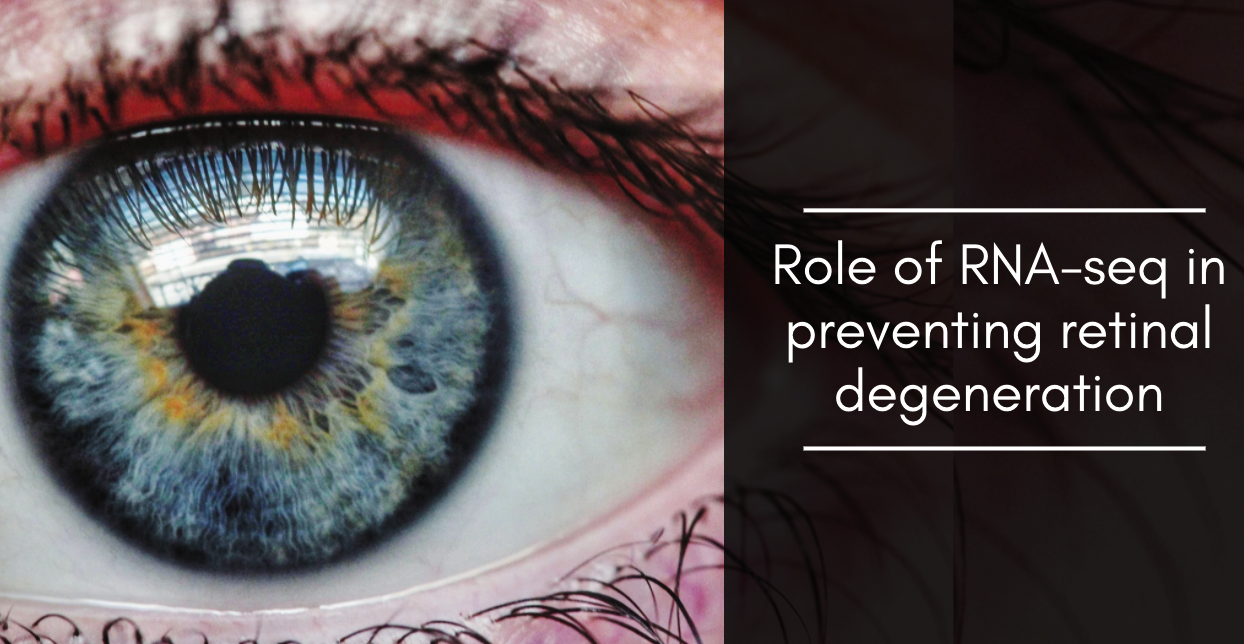RNA-Seq Works as a Groundbreaking Tool to Preventing Progressive Blindness Due to Retinal Degeneration
What is Retinal Degeneration?
As the prominent source of incurable low vision and blindness, Retinal Degeneration is a retinopathy characterized by progressive degradation of the retina. It is a neurological disorder influenced by hereditary mutations and/or environmental or pathologic impairment of the retina [1]. The retina is the sensory nerve layer at the inner posterior chamber of the eye. It is composed of rods and cones which receive light and transfer impulses from the optic nerve to the brain. This creates real images of what the eye detects and is translated in the brain [2].

RNA Sequencing
Sequencing refers to the order of bases in a section of DNA or RNA in order to analyze gene structure and its relation to gene expression as well as protein conformation. RNA Sequencing abbreviated, RNA-Seq is the sequencing method that employs next-generation sequencing technology to analyze the entire transcriptome (Whole Transcriptome Sequencing, WTS).
Next generation sequencing (NGS) normally employs the use of nano and micro technology to reduce the amount of sample required and also reduce the cost of reagents used in sequencing experiments. It applies to genome sequencing, genome resequencing, transcriptome profiling, DNA-protein interactions, and epigenome characterization. NGS tech has become a unique research tool in all fields of science due to its remarkable ability to cover large portion of transcriptome and produce millions of paired-end reads by using nano grams of input DNA or RNA, while retaining specificity and sensitivity [3].
https://www.novogene.com/us-en/services/research-services/transcriptome-sequencing/eukaryote-mrna-sequencing/
Role of RNA sequencing in Retinal degeneration
RNA-sequencing precisely produces thousands of genetic codes, storing many subtypes of RNA molecules, and has evolved into the benchmark of transcriptome gene expression quantification. RNA-sequencing has the power to advance our understanding of eye development and disease; it can reveal new applicants to improve our molecular diagnosis rates and highlight therapeutic targets for intervention [4].
The fast development of bioinformatic tools has facilitated a whole genomic characterization of the retina, which is essential to properly study the basic biological mechanisms involved in cellular physiology, morphology, and development, as well as disease. RNA sequencing studies can be used to characterize transcriptome of normal or diseased retina [5]. RNA-seq is thus a useful tool for addressing disorders such as retinitis pigmentosa (RP).
In the recent study[7], researchers, from China Pharmaceutical University, utilized the services of library preparation and sequencing services provided by Novogene Co. Ltd. and discovered expression differentiation of related genes plays important role in regulatory pathways of common retina diseases. RP is a group of retinal degenerative disorders gradually causing loss of vision. It occurs 1/5000 worldwide and most common inherited disease of retina. Gene mutation is the major cause of RP, specifically effecting rod cells, responsible for low light vision. Around 100 gene loci located on 50 different genes were responsible for causing inheritance and expression of RP. 20% of RP are autosomal recessive [6].
RP is also caused by autophagy and dysregulation. Autophagy is involved in the initiation of apoptosis and help in photoreceptors death. For suppression of autophagy, MTOR pathway has been very useful. It was observed that MTOR signaling proteins were decreased in retinal models. Evidences proved that loss of MTOR cause alteration in RP retina.
The protein, ubiquitously expressed transcript (UXT), is an androgen receptor trapped clone 27 protein that is encoded by the UXT gene. RNA-seq reveals the important role of UXT in preventing retinal degeneration through a recent study that showed UXT, the chaperone protein responsible for regulating inflammation and angiogenesis, acting as a novel MTOR regulator. They knockout, overexpress and minimize the UXT gene expression to pattern its effect on retinal degeneration and compared it with normal retina by RNA sequencing analysis. The sequencing analysis proved that UXT was highly expressed in adult retina. UXT deficient mice show drastic retinal defects at molecular, physiological and functional aspect [7].
Retinal ganglion cell (RGC) death caused by axonal injury is leading cause of Glaucoma, an ocular disease. RNA sequencing was used to investigate the underlying changes in molecular mechanism involved in axonal injury before the start of RGC death. Transcriptomic method to this analysis based on RNA-sequencing, was a powerful and effective method, and endorsed to gain a global view of gene expression changes in the retina after axonal injury [8].
References:
[1].Ji, H. He, H. Lin, D. Dietary Wolfberry and Retinal Degeneration. Handbook of Nutrition, Diet and the Eye. 2014; (47): 465-472. [ScienceDirect]
[2].Cambridge Dictionary. Retina. [CambridgeDictionary]
[3].Liu, L., et al., Comparison of next-generation sequencing systems. BioMed research international, 2012. [ResearchGate]
[4].Owen, N. Moosajee, M. RNA-sequencing in ophthalmology research: considerations for experimental design and analysis. Therapeutic advances in ophthalmology, 2019;11
[5].Farkas, M.H., et al., RNA-Seq: improving our understanding of retinal biology and disease. Cold Spring Harbor perspectives in medicine, 2015;5(9)
[6].O’Neal, T.B. and E.E. Luther, Retinitis pigmentosa. StatPearls. 2020.
[7].Pan, M. Yin, Y. Wang, X. Wang, Q. Zhang, L. Hu, H. Wang, C. Mice deficient in UXT exhibit retinitis pigmentosa-like features via aberrant autophagy activation, Autophagy. 2020 [Taylor&FrancisOnline]
[8].Liang, Q., et al., Single-nuclei RNA-seq on human retinal tissue provides improved transcriptome profiling. Nature communications, 2019;10(1):1-12.
